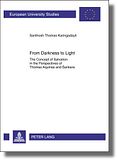From Darkness to Light
Karingadayil, Santhosh Thomas:
From darkness to light : the concept of salvation in the perspectives of Thomas Aquinas and Śankara / Santhosh Thomas Karingadayil. - Frankfurt, M. ; Berlin ; Bern [u.a.] : Lang, 2011. - XIII, 295 S. - (Europäische Hochschulschriften : Reihe 23, Theologie ; 918)
Hochschulschrift. Zugl.: München, Univ., Diss., 2011
ISBN 978-3-631-61890-5
EUR 52,80
DDC: 234.092; 294.522
Beschreibung
The question on salvation with its multifarious dimensions had always been a significant subject-matter of discussion from time immemorial. All the religious traditions attempt to formulate appropriate answers to the questions related to this, one of the most crucial issues in theological reflections. Still the concept remains wide open for further research. It is St. Paul who said that, «For now we see in a mirror, dimly, but then we will see face to face. Now I know only in part; then I will know fully, even as I have been fully known.» (1 Cor. 13:13) Salvation, as St. Paul conceives it, is a face to face vision of God in perfect knowledge merited through the person of Christ and through the gratuitous gift of grace. It is a passage from ignorance to truth, from darkness to light and from death to immortality (Br. Upa. I. iii. 27). From Darkness to Light aims at an enhanced understanding of the concept of salvation, comparing the theological and soteriological positions of Thomas Aquinas and Sankara. The author has made an admirable attempt in Comparative Theology, deciphering and clarifying all related concepts of salvation in both the thinkers. [Verlagsinformation]
Inhalt
Acknowledgements. V
Abbreviations Used. XIII
General Introduction. 1
PART I: FROM BONDAGE TO SALVATION
1. Sinful Man in Need of Salvation. 7
Introduction. 7
1.1 The Creation Narrative, a Christian Perspective. 8
1.2 Aquinas' Understanding of Creation. 9
1.3 Sin, a Black Mark in the History of Salvation. 19
Conclusion. 50
2. From Avidyā to Mukti. 53
Introduction. 53
2.1 Brahman, the Only Supreme Reality. 53
2.2 The Creation of the World. 61
2.3 Atman, the Principle of Breath. 66
2.4 The Advaitic Notion of Bondage. 76
Conclusion. 90
PART II: PROCESS OF SALVATION
1. Ways and Means of Salvation, Aquinas' Approach. 91
Introduction. 91
1.1 Acquisition of Knowledge as the First Step. 92
1.2 Faith, the Key to Salvation. 96
1.3 Christ as Mediator of Salvation. 101
1.4 Grace, the Medium of Salvation. 119
1.5 Sacraments, the Channels of Divine Grace. 134
1.6 Prayer and Meditation, A Bridge to the Divine. 148
Conclusion. 152
2. Śaṅkara and the Suggested Means of Salvation. 153
Introduction. 153
2.1 Karma Marga, the Path of Action. 153
2.2 Bhakti Marga, the Way of Devotion. 158
2.3 Jñāna Marga, the Path of Knowledge. 164
2.4 Meditation as the Path to Liberation. 171
2.5 Renunciation, a Negation to Possess. 184
2.6 Role of Divine Grace. 188
2.7 Rituals, a Fore-runner of Liberation . 190
Conclusion. 192
PART III: LIFE LIBERATED
1. Aquinas' Understanding of Salvation. 199
Introduction. 199
1.1 The Reality of Death. 200
1.2 Life after Death as Eternal Life. 202
1.3 Salvation, a Perfect State of Life. 215
Conclusion. 216
2. Śaṅkaras Understanding of Salvation. 219
Introduction. 219
2.1 Jivanmukti. 220
2.2 Videhamukti, a Notion of a Perfect Salvation. 226
2.3 Death, a Passage from Samsara to Eternity. 229
2.4 The Law of Karma and Rebirth. 231
2.5 Liberation as Perfect Union with Sat-cit-ananda Brahman. 234
2.6 The Conditions of the Liberated Soul. 237
Conclusion. 241
PART IV: A BRIDGE BETWEEN OR A WALL SEPARATING, A COMPARATIVE ANALYSIS
Introduction. 243
1. Similarity in the Approach to the Sources. 245
2. Similarity in the Concept of God: Summum Bonum or Sat-cit-ananda. 247
3. Esse Est Unum and Ekam Sat. 249
4. God and Creation. 251
5. Body, an Unavoidable Evil. 255
6. Sin and Avidya. 258
7. The Universal Character of Knowledge. 261
8. Meditation as Union with God. 267
9. Salvation as Perfect Happiness. 269
10. The Role of Grace 271
11. Mediatorship in Salvation 273
12. Jivanmukta an Advaitic Contribution 274
Conclusion. 276
Critical Appraisal. 277
Bibliography. 285
Autor
SANTHOSH THOMAS KARINGADAYIL, born in 1970 in Chempanthotty (India), belongs to the Congregation of the Friars Minor Capuchins. After his studies in philosophy and theology he was ordained priest in 1997. The duties assigned to him and the pastoral care of the expatriates in Gulf motivated him to do his higher studies in comparative theology. Having completed his doctorate from the Ludwig-Maximilians-University Munich, he is at present serving the needs of his province in Kerala.
Quellen: Peter Lang Verlag; Deutsche Nationalbibliothek; WorldCat; Buchhandel.de; Amazon (Deutschland).
Ähnlich
- Yelle: The Language of Disenchantment
- Religion, Kaste und Ritual
- Jeremiah: Community and Worldview among Paraiyars of South India
- Liebau: Cultural Encounters in India
- Sharma: From This World to the Next
- Hindu-Christian, Indo-German Self-Disclosures
- Webster: Historiography of Christianity in India
- Loseries: Tantrik Literature and Culture
- Missionary Discourses of Difference
- Religion, Science, and Empire

